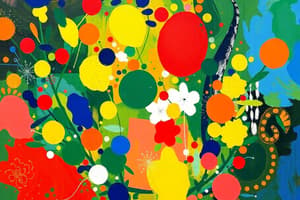Podcast
Questions and Answers
How do populations tend to grow in numbers?
How do populations tend to grow in numbers?
When the available resources are greater than that required by the members of the population present at that particular time.
What is biotic potential?
What is biotic potential?
Refers to the highest rate of reproduction possible for a population under ideal conditions.
In general, populations that grow under ideal conditions show ________________ growth.
In general, populations that grow under ideal conditions show ________________ growth.
Exponential growth
A graph of this growth is said to be ____ shaped.
A graph of this growth is said to be ____ shaped.
What are two common reasons for the exponential growth of a population? The first reason is...
What are two common reasons for the exponential growth of a population? The first reason is...
What are two common reasons for the exponential growth of a population? The second reason is...
What are two common reasons for the exponential growth of a population? The second reason is...
What are 4 factors that affect biotic potential? The first factor is...
What are 4 factors that affect biotic potential? The first factor is...
What are 4 factors that affect biotic potential? The second factor is...
What are 4 factors that affect biotic potential? The second factor is...
What are 4 factors that affect biotic potential? The third factor is...
What are 4 factors that affect biotic potential? The third factor is...
What are 4 factors that affect biotic potential? The fourth factor is...
What are 4 factors that affect biotic potential? The fourth factor is...
What type of animals typically have low biotic potentials?
What type of animals typically have low biotic potentials?
What is environmental resistance?
What is environmental resistance?
What sets the size of a population?
What sets the size of a population?
What is homeostasis?
What is homeostasis?
What are changes in human history that allowed us to live longer?
What are changes in human history that allowed us to live longer?
What is population growth?
What is population growth?
What is exponential growth?
What is exponential growth?
What is carrying capacity?
What is carrying capacity?
What is the beginning growth phase in population dynamics?
What is the beginning growth phase in population dynamics?
What is the rapid growth phase in population dynamics?
What is the rapid growth phase in population dynamics?
What is the leveling off phase in population dynamics?
What is the leveling off phase in population dynamics?
What is the carrying capacity phase in population dynamics?
What is the carrying capacity phase in population dynamics?
Flashcards are hidden until you start studying
Study Notes
Population Growth
- Populations grow when resources exceed the needs of existing members.
- Under ideal conditions, populations exhibit "exponential growth."
- Exponential growth is represented by a J-shaped graph.
Biotic Potential
- Biotic potential is the maximum reproductive rate of a population in optimal conditions.
- Factors affecting biotic potential include:
- Age of first reproduction (early maturation increases potential).
- Clutch size (number of offspring produced per reproductive event).
- Survival rate of offspring (proportion surviving to reproductive age).
- Frequency of reproductive events in an organism's lifetime.
Exponential Growth Triggers
- Populations introduced to new environments often experience rapid exponential growth.
- Recovery from disasters, such as floods, can also lead to a surge in population numbers.
Characteristics of Biotic Potential
- Large, slow-gestating animals generally have low biotic potentials.
- Environmental resistance consists of limiting factors that inhibit population growth.
Population Size and Carrying Capacity
- Population size is determined by resource availability and individuals' ability to utilize resources.
- Carrying capacity represents the maximum number of organisms an environment can support.
- Exponential growth curves transition to S-shaped curves when carrying capacity is reached due to resource limitations.
Stages of Population Growth
- Beginning Growth: Initial population increases as few members reproduce.
- Rapid Growth: As population increases, reproduction leads to exponential growth.
- Leveling Off: Growth slows as resource competition intensifies; graph resembles an S-shape.
- Carrying Capacity: Population stabilizes; exceeds this limit results in mortality.
Human Historical Changes Impacting Longevity
- Advancements in medicine and hospital care.
- Technological innovations, such as transportation and waste management.
- Increased education regarding food and stress management has influenced population dynamics.
Key Definitions
- Homeostasis: The internal stability maintained by living organisms.
- Population Growth: An increase in the overall number of individuals in a population.
- Exponential Growth: Growth pattern where larger populations grow faster, leading to a population explosion.
Studying That Suits You
Use AI to generate personalized quizzes and flashcards to suit your learning preferences.




